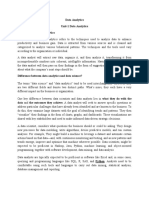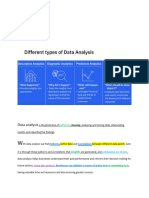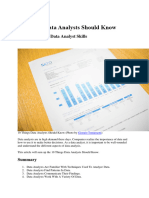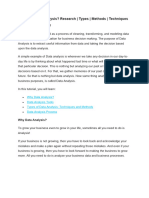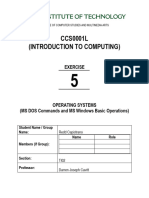Course 2: harnessing the power of data
analyst
Tasks of a data analyst
Introduction
Imagine you're a detective. Your task is to solve a mystery using many clues and data at your
disposal. This also describes the goal of a data analyst—they dive deep into data to uncover
hidden patterns, trends, and insights that drive informed decision-making. In today's data-
driven world, the role of a data analyst is critical to help organizations make better decisions
and stay ahead of the competition.
Are you ready to examine the data and help solve the mystery? If so, you’ll need to explore
the key areas that a data analyst will engage in during the data analysis process.
The data analysis process
Data analysis is the process of collecting, preparing, analyzing, and visualizing data to extract
valuable insights and support decision-making. The data analysis process has five critical
steps:
1. Prepare
2. Model
3. Analyze
4. Visualize
5. Manage
Let’s discover how each step contributes to data-driven decision-making.
1: Prepare
�Data preparation is the crucial first step in the data analysis process. In this stage, data
analysts gather, clean, and pre-process the raw data to make it suitable for analysis. This often
involves removing any inaccuracies, inconsistencies, or duplicate records, as well as filling in
missing values. Data preparation also includes data transformation, where data is converted
into a more suitable format for analysis. For example, if you're analyzing customer purchases,
you might need to aggregate individual transactions into monthly or yearly data.
2: Model
In the modeling stage, data analysts create a data model that represents the structure,
relationships, and constraints of the data. This involves designing a schema, which is a
blueprint of how the data is organized and stored. A well-designed schema helps analysts
query the data more efficiently and ensures the data remains consistent and accurate. There
are several types of data models, such as relational, hierarchical, and network models, each
with its own set of rules and conventions. When creating a data model, analysts must consider
various factors, such as the granularity of the data, the types of relationships between data
entities, and the business requirements of the analysis.
3: Analyze
This step is the core of the data analysis process, where data analysts dig deep into the data to
uncover insights and answer specific questions. Analysis can take many forms, including:
Descriptive analysis: Describe what the data looks like in its basic form.
Exploratory analysis: Dig deeper to try and find interesting patterns or relationships
between different parts of the data.
Inferential analysis: Use available data to make guesses or predictions about things
outside the data.
Predictive analysis: Use statistics to predict what might happen in the future based on
what's happened in the past.
During the analysis phase, data analysts use a variety of statistical and machine-learning
techniques to test hypotheses, identify patterns, and make predictions. For instance, a data
analyst might use clustering algorithms to segment customers into distinct groups based on
their behavior. Clustering algorithms are used to group data together based on their
similarities, such as grouping customers who behave similarly. Another example is using time
series analysis to forecast future sales, which is another algorithm data analysts might use to
predict future trends. This involves looking at patterns in data over time, such as sales
numbers, and using that information to make predictions about what will happen in the future.
4: Visualize
Data visualization is a powerful tool that allows data analysts to explore data, identify
patterns, and communicate their findings effectively. By creating charts, graphs, and other
visual representations of data, analysts can more easily spot trends, outliers, and relationships
between variables. This helps them gain a deeper understanding of the data and communicate
their findings to stakeholders in a way that's easy to understand. For example, a data analyst
working on a sales analysis project might create a map to show sales performance by region,
or a line chart to display sales trends over time.
�5: Manage
Data management is a critical aspect of the data analysis process that ensures the integrity,
consistency, and security of the data being used. This involves implementing best practices
for data storage, backup, and access control, as well as maintaining data documentation and
metadata. Proper data management helps data analysts and other stakeholders trust the data
and its analysis, ensuring that the insights derived are accurate and reliable. For example, a
data analyst might work closely with the IT department to implement data governance
policies and ensure compliance with data protection regulations.
Conclusion
Data analysis is an essential process that enables organizations to make informed decisions
based on insights derived from data. As a data analyst, you'll engage in five key areas during
the data analysis process: prepare, model, visualize, analyze, and manage. By mastering these
areas, you'll be well-equipped to tackle complex data challenges and help organizations
uncover the hidden value in their data. As a data analyst, you have the power to reveal hidden
truths, solve complex problems, and drive meaningful change.


